Day 1: Passing through Albania

We left Croatia yesterday and passed through Bosnia, Montenegro, and then reached Albania. We parked overnight at Camping Family in Gljirokaster, Albania. We arrived late so weren’t able to check out the ruins that make this city a UNESCO world heritage site. As we settled in, we looked out onto the Nemërçka Mountains behind us and the multitude of city lights on the hills in front of us. It reminded us of both of Diwali celebrations and twinkling Christmas lights. We miss home but remind ourselves that we are together here and it’s ok to feel conflicted about being happy in one place and missing another in the same moment.
Day 2: Arrival in Greece and Vikos Gorge
Each morning we are excited to wake up and see where we are. We left Albania this morning and have arrived in Greece! We instantly noticed the change to the Greek alphabet on all the signs but so far Google maps is holding up! We are in the northern part of Greece and have been blown away by its mountainous terrain and beautiful fall colors. The Pindus Mountains are majestic and make up a landscape we’ve never seen before. All around us are columns of rough multi-layered gray rock columns adorned by lime and forest green bushes, and trees with leaves of all shades of orange, red, brown, yellow that resembling a campfire. It is a scene that is other worldly.
Our first stop was to Vikos Gorge in the north Pindus mountains that is 32 km long and reaching depths ranging from 120-1350 meters and 2500 wide. It is listed as the world’s “deepest relative to its width” gorge by the Guinness Book of World Records. The drive up here in the RV was not the faint of heart – it was very windy and narrow, not to mention steep. We had about an hour to explore by foot to get back down before nightfall, but it was worth it. We hiked starting at the Beloi trail head and made it out to some amazing lookouts.
We booked it back to the RV and made our way back down the mountain during sunset and made it down before dark. On our way out however, we had to stop at this amazing site, the Bridge of Misiou, built in 1748 by the Alexis Misiou connecting the 2 villages of Vitsa and Koukouli. It is an architecture wonder and offers stunning views of the gorge at its southern end. We climbed the steps and were in awe of the scale of this structure!
We headed to our next destination, the rock formations of Meteora, meaning “into the heavens”, near the town of Kalabaka in central Greece. We pulled into Camp Vrachos at night and could view the amazing monolithic rocks which were lit up at night. We couldn’t wait to wake in the morning and visit the monasteries perched at the top of these mountains built in the 13-14th centuries.
Day 3: Meteora Monasteries
We woke to a magnificent view of the Meteora rock formations! Meteora is a fitting name for these majestic rock columns that soar into the sky. We read that these sandstone mountains were at once thought to be part of the landscape underneath the Adriatic Sea. The current theory is that earth shifts forced the seabed up 60 million years ago creating the rock pillars, that once exposed became rounded and smoothed over time by the winds and rain. At the top of these pillars lie the 14th century Eastern Orthodox monasteries built that are yes, you guessed it, designated UNESCO World Heritage sites!
We took the noon bus which zig zagged through these massive rock faces. There are 6 monasteries of the original 24 still open and operating today and visitors can hike up to and between the monasteries on a 14km circuit. We decided to take the bus up to the biggest monastery, Great Meteoron, at the highest point of the circuit, and then hike down to the others as time permitted.

The Great Meteoron Monastery, is the oldest and largest of the 6 remaining and was built in the 14th century by St. Athanasios the Meteoritein, who continued to add cells welcoming more monks to reside here in worship of the Virgen Mary. At one point during the 16th century the monastery had a hospital and was home to over 300 monks. We explored the grounds, church and overlooks and imagined the work of hoisting the materials to construct this structure. We learned that there are 3 monks still on site.
We followed the trail down to the Varlaam Monastery on foot, the second largest monastery of Meteora named for the monk who scaled the rocks in 1350 and began building it. The monastery was abandoned for 200 years after his death until two brothers - Theophanis and Nektarios Apsaradas - who were both monks, continued construction in the 16th century. The Varlaam monastery has a very different aesthetic than Great Meteora. For me, it resembled a Spanish or Italian villa, with its frescoes, clay planters, green plants, and earth toned walls.

We toured the rooms which included an ornately decorated sacred church, small garden. There's also a small room that housed the pulley system used to literally, hoist up monks in a thick net! We learned the monks would reach the monastery in 1 of 3 ways, by foot, by climbing up ladders tied together, or by being pulled up in a large net! Today, 7 still monks reside here.
The other monasteries were starting to close by this point, so we hiked back down to Kalabaka for lunch and then back to our RV camp site. In the evening, we were pleasantly surprised to see that we were parked next to 2 other families with kids! We met a family from Austria and another from the south of France and we had a blast playing Plaka a game like bocce ball but with rubber rings, Uno, and just sharing our experiences in RV life and traveling. We are grateful for the connections we made with both families and all the tips we shared with one another about places to explore.
Day 4: Meteora to Olympia

We said our goodbyes in the morning, cleaned out the RV, packed up and hit the road for Olympia. This is a longer drive in the RV than we’re used to – 5.5 hours from the central part of the Greece to the western Peloponnesian Peninsula. We are excited to see a new part of Greece known for its rich history and beautiful, warm beaches (hopefully). We crossed over the beautiful Patras bridge into Peloponnesia and settled in at our campsite, Camping Alfeios. In the morning we will go to the Olympia ruins, the birthplace of the Olympic Games!
Day 5: Olympia, birthplace of the Olympics!
We walked down from our RV camp site to the meeting point for our tour which was just 15 minutes away in the small town of Olympia. We are so excited to tour the ancient ruins where the Olympics began. This site is under continuous excavation and your can see numerous work sites in progress. We met our amazing tour guide, Elena, who is from Olympia, and the learning began. We learned that the Olympia’s ancient ruins we were standing in are 3,000 years old!


The Olympics began as a celebration of the Greek gods, lasted 5 days, and every Greek citizen made this journey once in his or her life to watch the games to pay respects to the gods and particularly, Zeus. However, only aristocrats were allowed to participate in the games, and mainly heads of states from Greece, its islands, and other lands that are part of the Greek diaspora such as Sardinia, Turkey, and Sicily to name a few. Athletes trained their minds and bodies for sports such as wrestling, chariot racing, the javelin and shot put, and there was only 1 winner for each sport. Archeologists have reconstructed what is now understood to be the gymnasium (a Greek word) where athletes trained and prepared for the games.
We learned about Phidias, the Greek architect and artist, who designed the 7ft statue of Zeus that was the center piece of Olympia and one of the 7 wonders of the ancient world. He is the same architect of the Acropolis in Athens and it is his statue of Zeus that inspired Michelangelo later during the Renaissance period! Only the base exists today. The statue itself was removed by the Romans when they came to conquer Greece and brought with them Christianity. At this time, in 330 AD, the Olympics were stopped, as worship to the Greek gods was no longer allowed. Olympia and the Olympics were abandoned for 1500 years! In 1869, they started again, the torch was lit and is lit here still every 4 years for the Olympic games.
Olympic stadium was our final stop of the tour. We entered through the stone walkway reserved for athletes and imagined 45,000 spectators cheering us on as we entered the track that, as legend has it, was measured by Hercules himself – 600 Herculean feet to be exact! We did some sprints up and down the track and had our own medal ceremony – in ancient times the prize was an olive branch crown!
Only men were allowed to compete in the Olympics but there were games that girls and women could compete in called the Heralian Games, named after Zues’ wife, Hera. Asha and I represented! Even though the Olympics started out as male dominated and only for aristocrats, the spirit of the Olympics today is about inclusion and peace. Even in ancient times, wars were stopped temporarily during the 5 days of the Olympic games. The 5 rings of the Olympic flag represented the 5 continents that were believed to exist at the time and the 5 colors of the rings were chosen to national flags – it is said that all flags have at least one color included in the rings of the Olympic flag.
After our tour we had a couple of hours to visit the free Archimedes museum and we loved it. It pays homage to Archimedes, the Greek mathematician, inventor, engineer born in 287 BC in Sicily, and his scientific investigations and achievements. A local engineer created this museum using models built using Archimedes' drawings and we loved the hands on nature of the exhibits. It was lots of games and puzzles and really fun way to pass the afternoon.
We really liked the small town of Olympia. Everyone was welcoming and we had some delicious Greek food while we were in town - Greek salad, giant beans, pita and tzadiki. We are off tomorrow to the east coast of the Peloponesse to Nafplios, the first capital of Greece.
Day 5-9: Drepano beach and Nafplios
We found a great little beach off the beaten path in nearby Drepano, a town about 15 min. outside of Nafplio which was our original destination, but has no RV parks in its city center. Today we arrived in the evening, threw on our suits and took our first swim in the Mediterranean! It was a bit chilly but we’ve swam in colder waters - glacier-fed Bowe Lake in the Canadian Rockies comes to mind! The water here is a beautiful light blue and so clear. We have our goggles so have been enjoying seeing the multitude of different fish swimming around us!


We had a good night’s rest night and today we rode our bikes to Tolo beach which is more populated. Biking the backroads is pretty much flat and lined with pomegranate and citrus trees bursting with abundance. There's only 1 big hill to get to Tolo so it’s a nice quick day trip for a change of scenery. We will be back tomorrow with out swim suits. This evening, as luck would have it, we found our friends that we met in Meteora in the neighboring camp! We swam with them and caught up on our adventures.
During out last couple of days we returned for some swimming in Tolo, and also visited Nafplios. It is a quaint, colorful town with lots of shops, playgrounds, and cafes. The waterfront is perfect for a relaxing drink and snack while looking out at the beautiful blue waters. We also checked out the Greek Folk Museum and read about traditional Greek dress and history.
We finished up the day with some playground fun and ice cream and walk along the water. It was dark by the time we got home. We made a late dinner, took showers and it was bedtime. We leave for Corinth tomorrow to stay 1 night to pack up and clean out the RV in preparation for returning it back to the owner. We have a long cleaning and travel day tomorrow. The sights of Corinth will have to wait for our next trip!
Day 10: Arrival in Athens
We dropped the RV at an RV parking site outside of Athens and are staying in an airbnb in the Syntagma Square, a very lively neighborhood with its own metro, cafes, shops, restaurants and walking distance to many ancient ruins. We arrived at night and felt the huge shift from RV living with few fellow travelers to big city spaces and crowds. We saw la diversity of cuisines - Indian, sushi, noodles and large supermarkets with aisles of options. We were passed in the streets by multitudes of city goers enjoying the night air, and we loved it all. We like Athens. We arrived back at the airbnb, made dinner and called it a night. We slept in beds where we could sit up and not bump our heads on the RV roof, and sat on a couch. We miss the RV for sure, but it's nice to have a little space.
Day 11: Athens City tour, Tomb of the Unknown Soldier, and the Acropolis
We hurried out to our 10am FreeTour Athens city tour and made it just in time to the meeting point, Monastraki flea market. We learned so much from our tour guide Stavros! Here are a few highlights:
Athens is the birthplace of democracy! Political leaders were assigned to the assembly for 1 month terms. this meant there were 400 citizens - male, over age 18 yrs. and whose parents were both Athenian - that served a 1 month term making decisions about how to run the city. Sounded a lot like jury duty to us!
The Athenians invite all 12 Greek gods to come to a competition to name the city. Only Poseidon and Athena showed up. Each was invited to perform a physical feat and the winner would be immortalized in the name of the city. Poseidon struck the ground with his trident and brought salt water spring appeared. Athena on the other hand, struck the ground and an olive tree arose from the ground. The citizens chose Athena's gift as it would lead to economic prosperity and so the city is named Athenia and not Poseidonopolis!
Athens history is rich, complicated and always evolving to the present day. Athens has been invaded and ruled by the Greeks, Persians, Macedonians, Germans, Spanish, Romans, and Ottoman! Our tour was a historical tutorial that made my head spin - wow!
We passed by the Tomb of the Unknown Soldier and saw the changing of the guard. Stavros explained that the guards are elite national guard soldiers who guard the tomb and parliament. Their skirt has 400 pleats to represent 400 years of slavery under Ottoman rule. The pom pom on their shoes hides a knife that could be used in battle. Their movement mimics the movement of a horse to represent the calvary. Each sunrise and sunset a troop marches to the top of the Acropolis to raise (in the AM) and then take down (in the pm) the Greek flag.


After the tour, we grabbed a quick lunch and walked for about 10 minutes to the entrance, bought our tickets - 10 euros each and began the climb up to the Acropolis or "high city" - the ancient citadel and heart of the city - which just left us in awe! Periciles' is the architect credited with driving the massive building program in the 5th century BC that resulted in these iconic buildings that are world renowned. We could not believe our eyes - these structures and the skill that created them left us awestruck. We entered and were immediately stunned by our surroundings.
We passed the Odeon of Herodes Atticus, and 5000 amphitheater built while Romans ruled Greece and is still used today for performances. It was built in 161 A.D. by Herodes a great orator and landowner, in memory of his wife.


We then entered through the Propylaea, known as one of the grandest gates ever built with its Doric columns. We felt so fortunate to be walking through the same gates that many had come through since the 5th century for such events as the Panathanaic Festival held every year to celebrate the birth of the city! To one side we saw the Temple of Athenia.
Then it was off the main showstopper - the Parthenon! Words and photos cannot capture the beauty of this amazing temple dedicated to the goddess, Athena. The columns rise 34 ft into the sky and these and other structure of the Parthenon were constructed of 100,000 tons of marble . It is under constant renovation to restore the marble columns and walls, and if built anew today, the cost would be over a billion dollars!

The Erechtheion is overshadowed but is the equally prestigious temple whose most famous feature is the 6 female statues that hold up its roof, and called the Porch of Caryatids. In one section of the temple, we could see the crack in the marble where Poseidon struck his trident, and an olive tree that marks the sacred place where Athena won her battle for the naming of they city. This temple is the one that can be seen from the city below in the Plaka neighborhood.


We finished up our visit by taking in the amazing views of the city from the lookout point where the Greek flag is flown every day. As luck would have it, we were there when the military guards came in to take it down the evening. The sunset over the Acropolis is an experience we'll never forget!
Day 12: Ilias Lalalounis Jewelry Museum and Acropolis Museum
We had a rainy morning which made this day a perfect museum day. We first went to the Ilias Lalalounis Jewelry Museum created by the renowned Greek jeweler, Ilias Lalalounis. It was opened in 1994, is the first of its kind in Greece and one of only 3 in the museums in the world devoted to the art of jewelry. It was on the smaller side in space but its collections were impressive and gave us a new appreciation of jewelry as an art form. Internationally renowned goldsmith, Mr. Lalalounis created collection inspired by Greek art and global events. He created collections reflecting the multicultural influences and artistry in Athens since the the time of the Mycenaeans to modern day. He was also commissioned to create the torch that is used to light the olympic torch every 4 years for the Olympics. There are only 3 in the world and one is the museum! He also created a collection to commemorate the US lunar landing on the moon which included earrings for Jackie Onassis in the shape of moons.
Next we were off to the Acropolis Museum to see more of the artifacts preserved from numerous past and current excavations. Our jaws dropped repeatedly as we saw sculptures from the facade and pediments of the Parthenon, and countless artifacts such as pottery, dolls, clay animals and reliefs. We loved seeing the original Caryotids from the Erechtheion up close. Five of the Caryotids were moved inside in 1979 to halt the impacts of pollution and then cleaned with a detailed laser technique. They are breathtaking! We loved this museum and could have been spent many more hours here.

We will spend tomorrow packing up and then take off on Tuesday evening to Marrakech, Morocco, with a layover night in London in between. We are ready to say goodbye to Europe and are so grateful for all we experienced here. See you in Morocco!




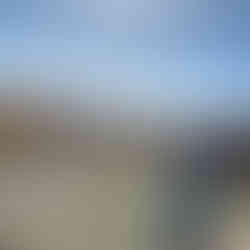






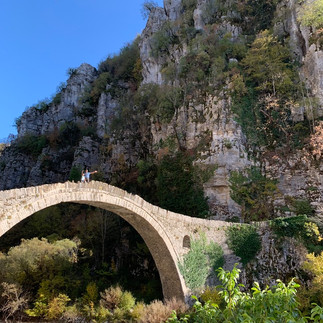

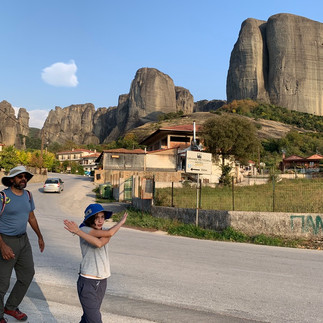

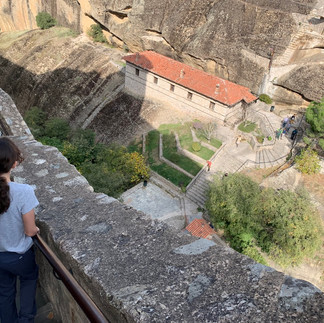







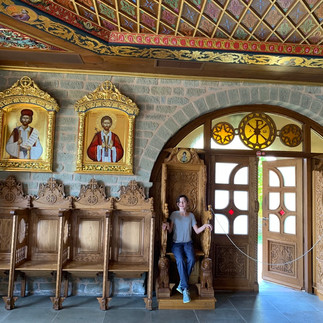










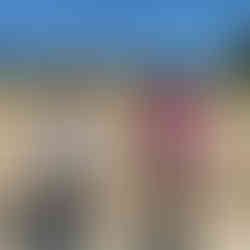












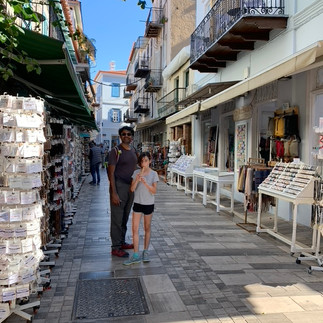









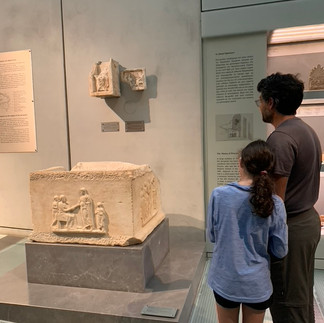


Comments